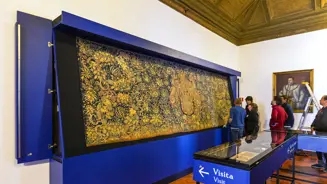Rare 16th-century tapestry returns to the National Palace of Sintra after restoration
18 Jan 2023
One of the greatest treasures of the National Palace of Sintra collection is back on the monument's exhibition circuit after a conservation and restoration intervention has restored its splendour. The piece in question is the rare mille fleurs tapestry with the Portuguese Royal Arms, dating from the early 16th century and probably produced in Flanders. It is one of the oldest tapestries in Portugal and, among them, the only one associated with the Portuguese Royal House or King Manuel I, whose personal emblem – the armillary sphere – is represented in the four corners of the piece.
Incorporated into the collections of the National Palace of Sintra in the 1960s, this tapestry has always had a prominent place in the exhibition route and only left the monument to appear in important exhibitions such as "Brazil 500 anos" in São Paulo in 2000, and "Lords of the Ocean" in the Kremlin museums in 2017.
In mid-2021, as part of the commemorations of the 500th anniversary of the death of King Manuel I, the piece was loaned to the Museu Nacional de Arte Antiga for the exhibition "Vi o Reino Renovar". Following this loan, the museum decided to invest in its conservation and restoration, with the support of the team from the National Palace of Sintra.
In the studio of Luís Pedro, a specialist in textile conservation and restoration, the tapestry, made up of delicate cotton, wool and silk threads, was the subject of a meticulous intervention aimed at removing dirt, stabilising lacunae, revising the suspension system, and replacing the lining.
New museography highlights and frames valuable tapestries
In order to give prominence to this valuable piece and accommodate it properly on its return, Parques de Sintra invested in the preparation of new museography in the corridor leading to one of the most emblematic rooms of the National Palace of Sintra: the Blazons Hall. The space, which is part of the exhibition centre dedicated to memory, is now dedicated to the theme of the continuity of the Portuguese coat of arms from the beginning of the Monarchy to the present day, presenting an important set of pieces that reveal how the shield (with its red border, gold castles, and shields with bezants) has been used by the organs of power over the last 800 years.
Standing out on the wall is the rare 16th-century mille fleurs tapestry with the Portuguese coat of arms. After the conservation and restoration work, this tapestry has regained its splendour and is now on display in a showcase specially designed to protect it and ensure its preservation, while still allowing all visitors to enjoy it.
Characterised by a background filled a composition of "a thousand flowers", the mille fleurs tapestries were among the most successful textile productions in the Netherlands throughout the 15th and 16th centuries. It is not possible to determine the exact origin of this specific piece, but its typology suggests that it was produced by a Brussels manufacture, the main centre of Flemish production at the time, probably as a royal commission.
The coat of arms depicted in the centre of the tapestry corresponds to the one used between the reigns of King João I and King João II, before the reform of the royal coat of arms that led to the removal of the fleurs-de-lis, symbol of the Cross of the Order of Avis, and the alteration of the shields in the centre of the coat of arms. The inclusion of the armillary spheres, the emblem of King Manuel I, reveals that the tapestry certainly dates from a later time, however. As museologist and tapestry specialist Maria José de Mendonça explains, this is "a unique piece in the Portuguese State. Heraldic tapestries with Portuguese coats of arms are very rare, particularly with royal coats of arms."
Between the middle of the 15th century and the end of the 16th century, Portugal commissioned important series of tapestries from Flanders. Those with the Portuguese coats of arms are extremely rare. These sumptuous pieces lined the walls and protected the rooms from cold and damp. At the same time, they were an important vehicle for visual propaganda and for the affirmation of the king's power.
The new museography of the Corridor of the Blazons Hall also presents a set of objects that feature the Portuguese coats of arms, such as portrait paintings, coins from the First Dynasty (found in an archaeological excavation in the palace), a 14th-century tile, a facsimile of the Book of Nobility and Perfection of Arms (the original from the 16th century), a desk, a plate and a paperweight from the 17th to 19th centuries, and a set of stationary from the 19th and 20th centuries.

